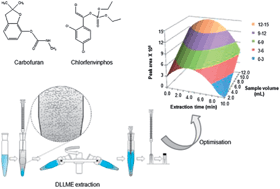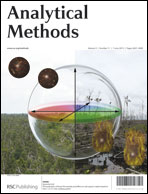A very simple and sensitive method was developed for the simultaneous determination of carbamate and organophosphorus pesticides in water samples, using dispersive liquid–liquid microextraction (DLLME) coupled with gas chromatography-mass spectrometry (GC-MS). Carbofuran and chlorfenvinphos were used as model molecules in this study. The optimisation of some important DLLME parameters (type and volume of extraction and dispersive solvents, sample volume, extraction time, and use of NaCl) was performed using a design of experiments approach. Under optimised conditions of the DLLME methodology (500 μL of methanol, 80 μL of chlorobenzene, 10 mL of aqueous sample, 4 minutes of vortexing and no salt addition), the calibration curve was linear in the concentration range of 0.1–250 μg L−1 for carbofuran and 0.1–200 μg L−1 for chlorfenvinphos. The limits of detection (LODs) were 0.04 μg L−1 for the carbamate and 0.02 μg L−1 for the organophosphorus pesticide. The proposed method was successfully applied to the analysis in river, mineral and tap water samples, yielding satisfactory results.

You have access to this article
 Please wait while we load your content...
Something went wrong. Try again?
Please wait while we load your content...
Something went wrong. Try again?


 Please wait while we load your content...
Please wait while we load your content...